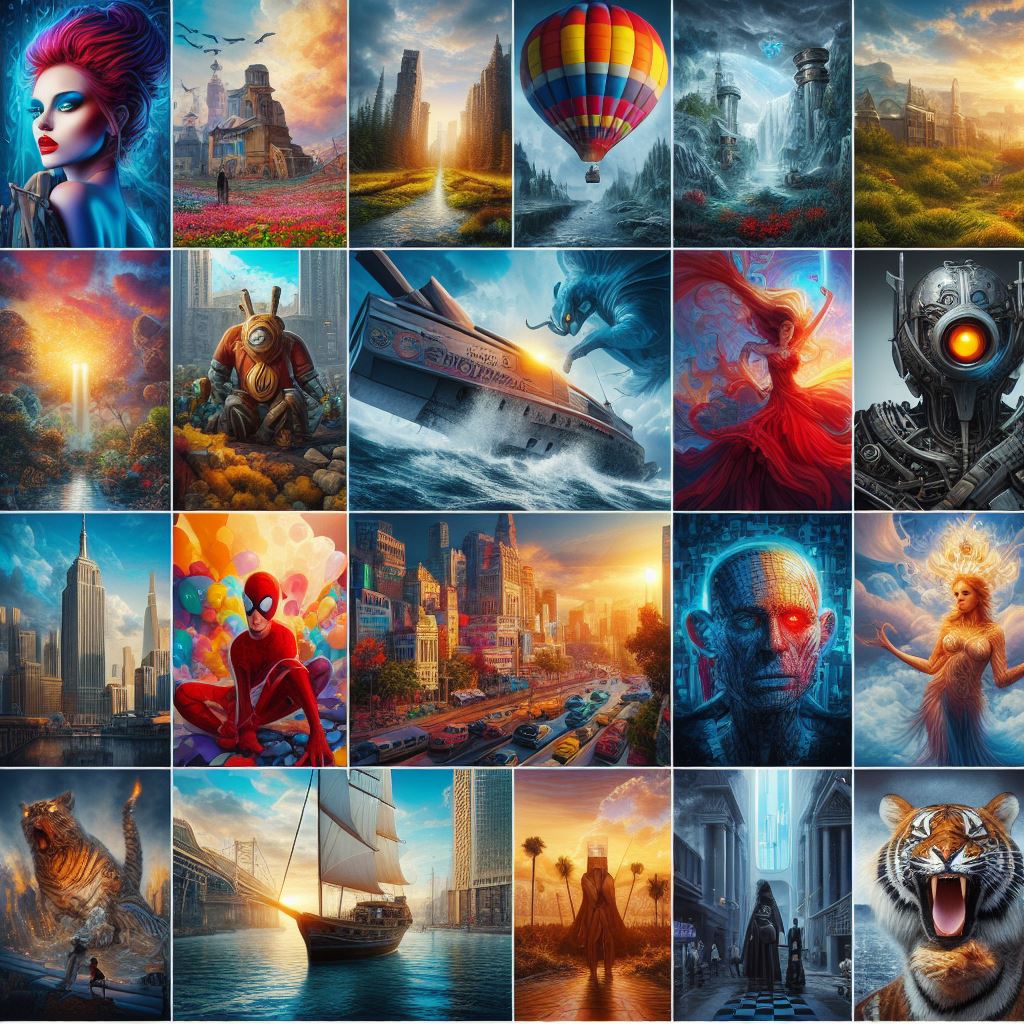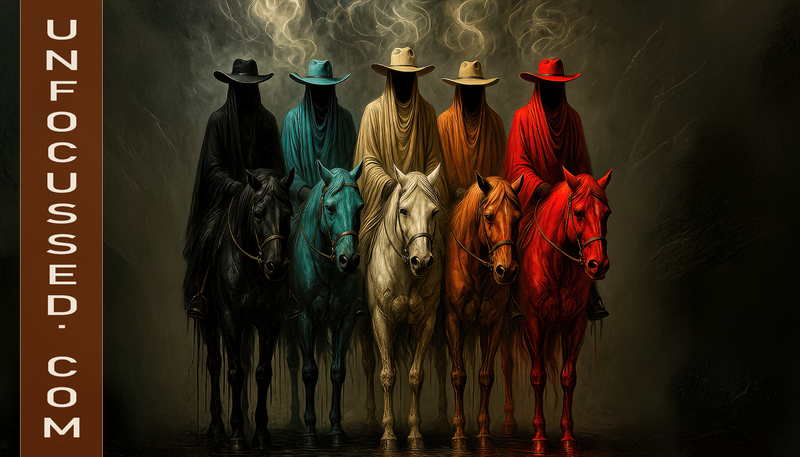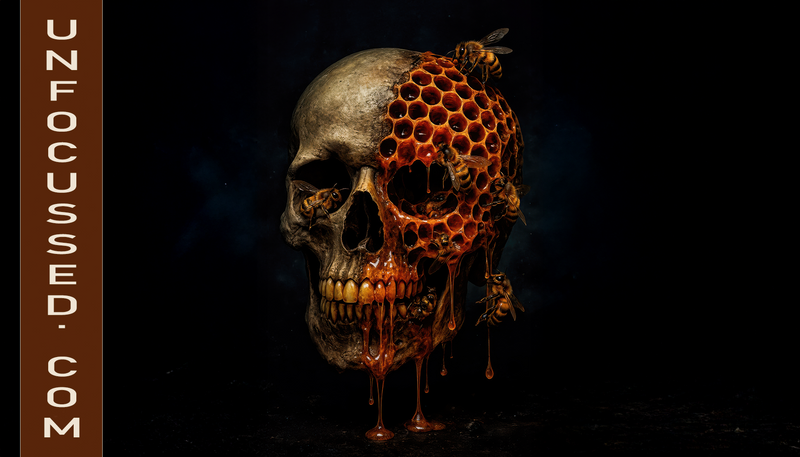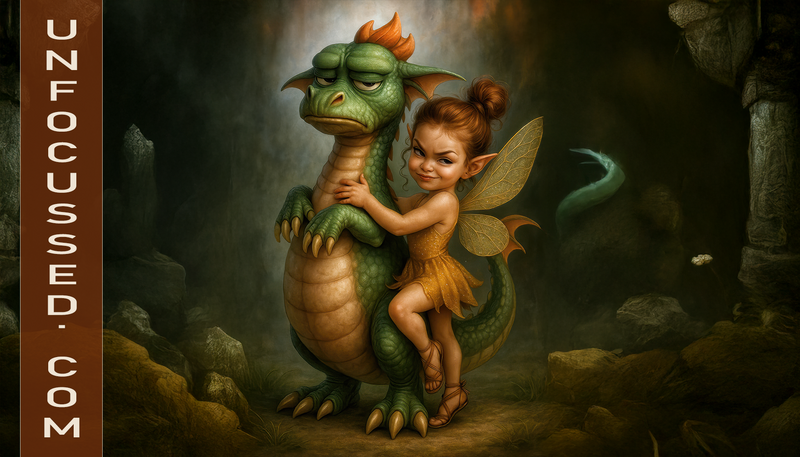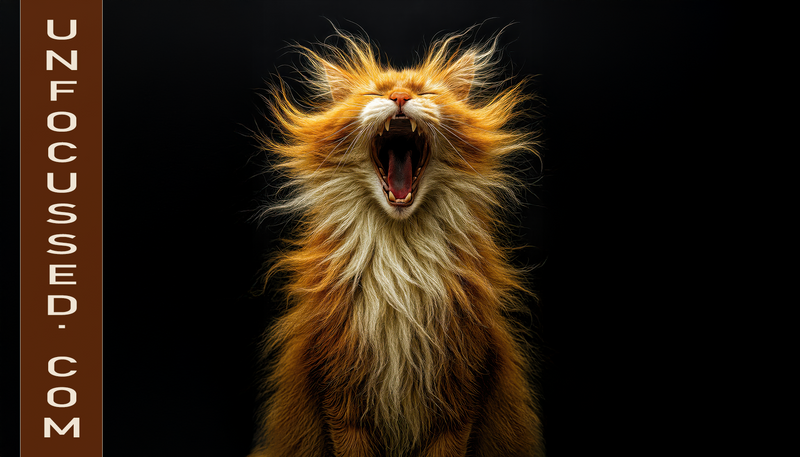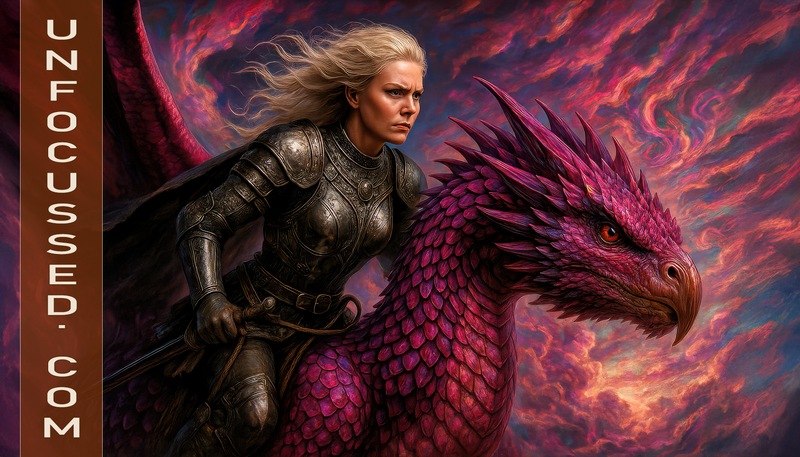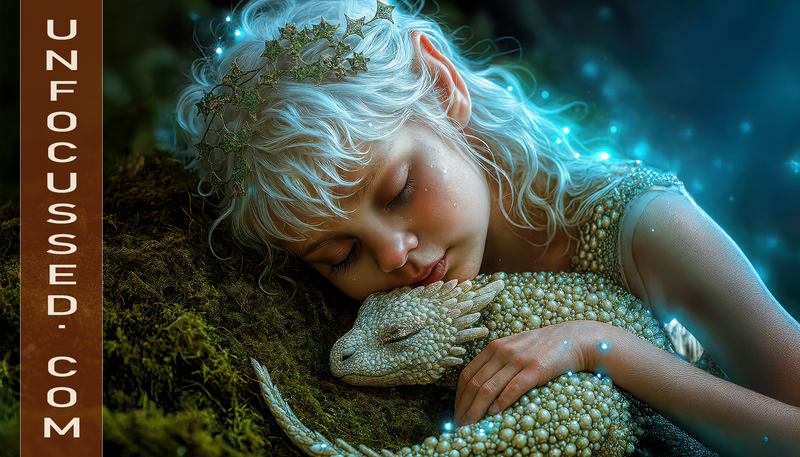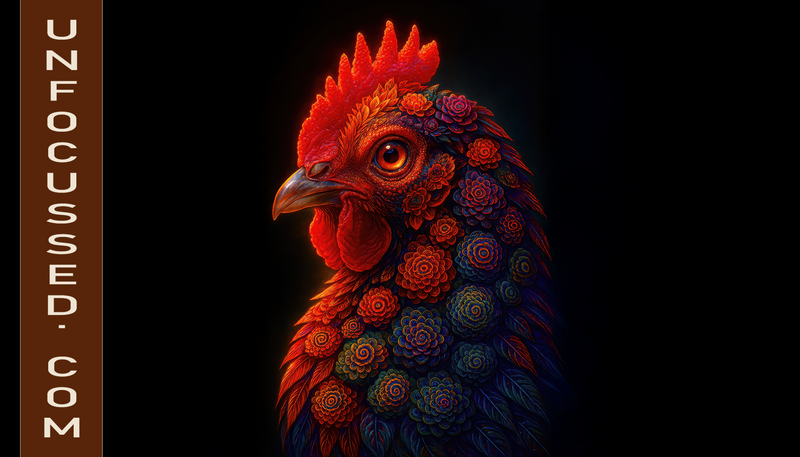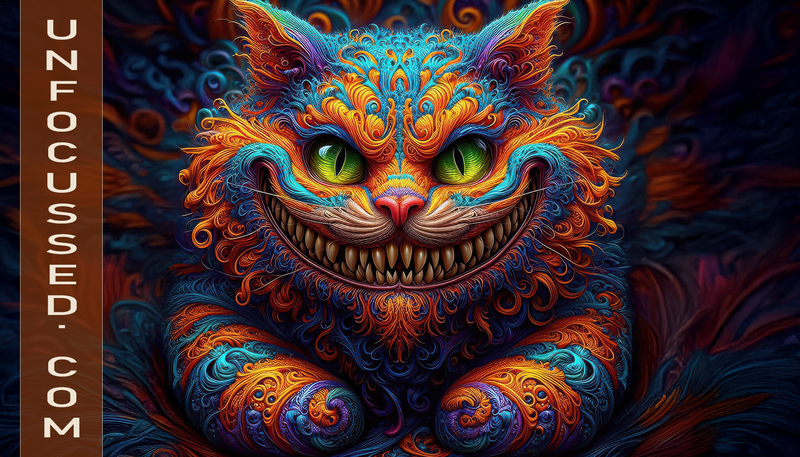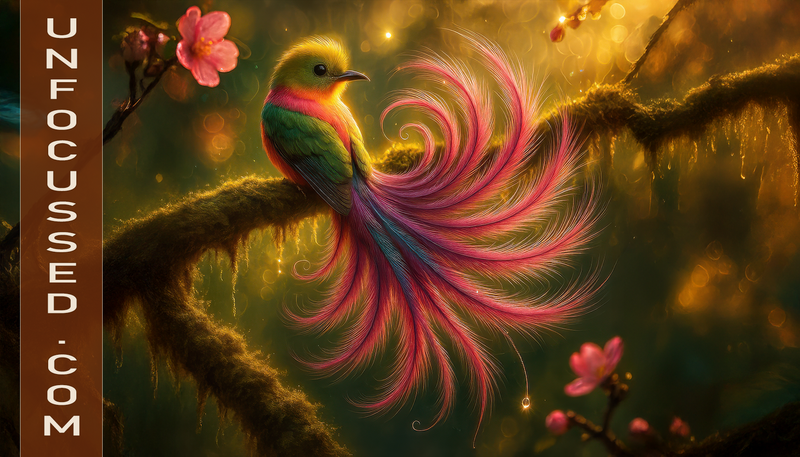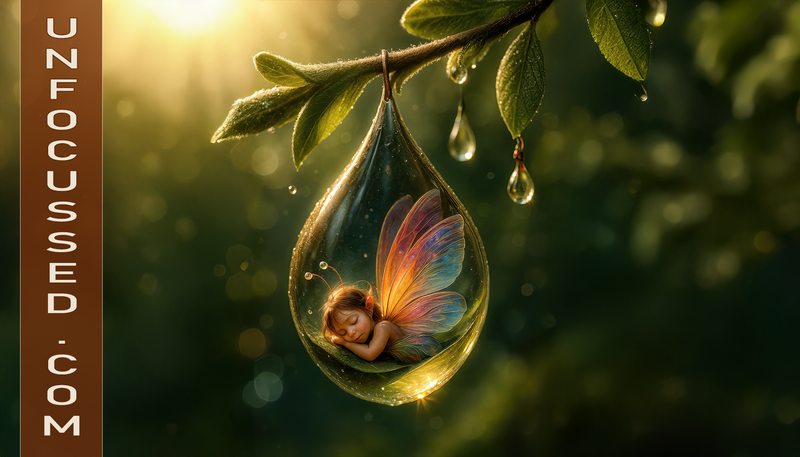Cuentos capturados – por Bill Tiepelman
Rage from the Egg
Shards, Smoke, and a Bad Attitude
The egg didn’t so much hatch as declare war on complacency. It split with the sound of a wineglass meeting a tiled floor after an “I deserve better” speech—clean, decisive, cathartic. Purple-and-brown scales pressed through the fracture like midnight lightning under varnish, and two molten-amber eyes snapped open with the unmistakable look of someone who woke up already annoyed with the universe. A talon hooked the shell’s rim—black, glossy, and ready to write a strongly worded letter to fate—then another, and then a snout, ridged and ancient, inhaled the world for the very first time.
If you’ve never seen a newborn dragon glare, imagine a house cat who paid taxes. There was grievance. There was grievance interest. The hatchling flexed, scattering shards that pinged off the rocks, and the forest went quiet in that respectful way nature gets when it realizes it might have just acquired a new landlord. A coil of warm smoke leaked between needle teeth, smelling faintly of singed cedar and smugness.
She—because the energy was absolutely “ma’am, that’s my throne”—tested her jaw like a boxer flexing before round one. The purple in her scales wasn’t cute-lilac; it was bruised twilight, the color of expensive secrets. The brown was weathered oak and old leather—practical, grounded, something you trust to outlive your worst decisions. Every plate of scale caught the dim light with hyper-realistic texture, as if some obsessive artisan had hand-carved each ridge and then whispered, “Yes, but meaner.”
“Congratulations,” I said from my respectable distance behind a very humble boulder. “Welcome to the world. We have snacks. Mostly each other.” I’m a freelancer—field notes on mythical creature photography pays in prestige and bruises—so a baby dragon hatching fell half under career goals, half under what if my mom was right. The hatchling swiveled, pupils thinning to predatory slits. Her gaze pinned me the way a magnet finds the only paperclip you actually needed.
She hissed, but it wasn’t an animal hiss. It was the sound of a stranger pulling your latte without asking and checking their phone while they do it. The jagged eggshell scraped as she dragged it with her—little queen in a cracked chariot—then froze to sniff the air, nostrils flaring like bellows. Ozone. Sap. My deodorant, which had promised “mountain breeze” but apparently translated to “come eat this nervous photographer.”
“You’re okay,” I said, lowering my voice to the register reserved for skittish horses and tax auditors. “You’re safe. I’m just here for… documentation.” I didn’t add and merch, but I’m not made of stone. This was baby dragon art in the wild—dragon hatching meets “look at those dragon scales” meets “I will absolutely buy a mouse pad of this if I survive.”
She rumbled—a tiny earthquake with big dreams—and stretched, her spine articulating in a ripple of purple dusk. Claws cinched the shell lip and she levered herself higher, a gymnast mounting a very dramatic pommel horse. The pose was… photogenic. Cinematic. Sellable. The forest floor seemed to lean into her; even the rocks wanted a selfie.
That’s when the ravens arrived. Three of them, black as tax law, swirling down as if someone had uncorked a flute of night. They perched in a triangle: two in the branches, one on a snag with the casual menace of a bouncer named Poem. Ravens love a myth in progress. They also love shiny things, and this baby had talons like patent leather and eyes like stolen sunsets.
“Shall we not,” I whispered toward the birds, who ignored me the way glitter ignores your attempts to vacuum it. The hatchling noticed them and something ancient lit behind her eyes—coded memory, baked into the DNA of things that once taught fire how to behave. She uncoiled just enough to look bigger. The air changed. My breath decided it had somewhere else to be. The ravens shuffled. The forest held its applause.
Then—because destiny enjoys good staging—the wind shifted and brought the scent of boar. Not a delicate hint. A statement. Wild pig: the bar fight of the forest. The boar lumbered into the clearing like a security deposit who’d learned to walk: a wall of bristles, tusks, and unresolved issues. He saw the broken egg. He saw me. He saw the hatchling, who—if we’re being honest—looked like a fancy snack with knives.
The baby dragon’s expression sharpened: from “everyone is already on my nerves” to “and now you.” The boar breathed steam and pawed the leaves, etching a rude letter to the season. He had size, sure. He had momentum. What he didn’t have was a working understanding of mythology.
“Don’t,” I said, which is exactly the kind of helpful field advice that has kept me alive this long by sheer accident. The boar didn’t speak human, but he was fluent in drama. He charged.
The hatchling’s first move wasn’t fire. It wasn’t even teeth. It was attitude.
She met the rush by snapping her head forward and slamming her eggshell against the ground with a crack that traveled up my spine. The echo spooked the boar just enough to wreck his line. She followed with a lunge that was part pounce, part angry thesis paper, talons flashing. Sparks leapt where claw met rock—tiny, indignant constellations—and the smell of hot mineral hit like a struck match. The ravens croaked in a single chorus that translated cleanly to: Ooooh, she’s spicy.
Boar and hatchling collided in a tumble of fur, scale, and undignified squeals. She was smaller, yes, but she was geometry and leverage and a very personal vendetta against being underestimated. Her tail—thorned, surprisingly articulate—whipped around to hook the boar’s foreleg while her front claws raked shallow lines across his shoulder. Not mortal. Not yet. A warning letter carved into meat.
The boar juked, throwing her sideways. The shell shattered further, eggshell confetti fluttering like an invitation to chaos. She rolled, planted, and came up with an expression I’ve seen on three exes and one mirror: try me. The boar’s courage faltered. Not big enough to back out gracefully, not smart enough to bow. He dug in for another charge.
This time she inhaled. Not just air—heat. The temperature around us stepped up like someone turned the sun’s settings to “simmer.” The purple in her scales drank the light; the brown went ember-warm. Smoke curled from the corners of her mouth in thin, disciplined threads. It wasn’t a blast. She didn’t have that yet. It was something more surgical: a cough of fire, tight as a secret, that zipped across the boar’s path and licked the ground into a glowing brand.
He froze mid-stride, skidding, eyes wide at the orange ribbon of that shouldn’t be there. The forest exhaled at once. Leaves hissed. Sap snapped. My camera—bless her anxious heart—clicked twice before my hands remembered they were attached to a survival plan. The hatchling padded forward, small, slow steps that said I am learning the choreography of fear, and you are my first partner.
She stopped so close to the boar that her reflection burned in his eyes. And then she smiled. Not nice. Not theatrical. A smile that promised that the category prey was a temporary misunderstanding. The boar backed up, breath wheezing, dignity looking for an Uber. He turned and fled into the trees, cracking deadfall like fresh bread. The ravens laughed, which should be illegal, and shook the branches until the leaves applauded anyway.
The hatchling settled on the ruined cup of her egg and looked at me as if I’d been an extra in her debut. There was soot on her lips like rebellious lipstick, and a chip of shell stuck to her brow ridges like a careless crown. She tasted the air again—my fear, the boar’s retreat, the iron tang of her own new fire—and made a soft, satisfied sound that felt older than memory.
“Okay,” I said, voice cracking into a register only dogs and bad decisions can hear. “You’re… perfect.” I meant it the way you mean sunrise and revenge. Purple dragon. Brown dragon. Newborn mythical beast. Fierce hatchling. Fantasy artwork had suddenly become fantasy witness. And something else whispered at the back of my brain: this wasn’t just a good picture. This was a legend learning to walk. A dragon portrait the world would try and fail to tame.
She blinked slowly, then lifted one talon and—like every bratty heiress of power—gestured. Not a threat. An invitation. The message was unmistakable: Follow. Or don’t. The river of her story would flow either way, and I could choose to drown in wonder or stay on the shore with the polite people.
I chose wonder. I chose rocks in my shoes and scorch marks on my sleeves and a camera that would smell like campfire for a month. I chose to step from behind the boulder, hands open, and trail the hatchling as she padded toward the treeline with her broken egg dragging behind like a royal train. Above us, the ravens spun a lazy orbit, three punctuation marks at the end of a sentence the world hadn’t learned to read yet.
That was when the ground hummed. Barely. A teeth-rattling murmur from somewhere deeper in the valley, then a second note, lower, older, like cathedral bells under the dirt. The hatchling’s head snapped toward the sound. The forest went from quiet to church-silent. She looked back at me with those burning eyes and, for the first time since she cut herself free of forever, she didn’t look angry. She looked… interested.
Whatever had made that sound wasn’t a boar. It wasn’t afraid of her. It wasn’t impressed with me. And it knew we were listening.
The hatchling stepped into the shade, and the purple of her scales deepened to stormwater wine. She flicked her talon again: Come on, slowpoke. Then she vanished into the green, a rumor in motion, while the valley’s subterranean bell tolled once more, long and ominous, promising that the story we’d just begun had teeth much bigger than hers.
Bells Beneath the Bones
Following a baby dragon into the woods sounds like the sort of activity you’d find on a list of “Top Ten Ways to Test Your Will to Live,” right between “poke a sleeping bear” and “start a conversation about cryptocurrency at a family reunion.” But there I was, trudging after her, my camera bouncing against my chest, my boots swallowing mud with the kind of enthusiasm that makes shoe stores rich. The air had shifted—thicker, damp, scented with moss, old stone, and the coppery tang of rain that hasn’t happened yet. That subterranean bell tone rolled again, slower this time, like the heartbeat of something that had seen empires rise and politely implode.
The hatchling glanced over her shoulder, not slowing, her eyes half-lidded with the confidence of someone who knows exactly where they’re going and also that you will follow because you have no other viable life choices. Her tail dragged a shallow trench in the loam, carving an accidental breadcrumb trail for predators with excellent taste in exotic entrées.
We moved deeper, under a canopy so thick the daylight fractured into narrow gold blades. Every few steps, she’d pause—not in fear, but in that considering way cats do before they either leap onto your lap or destroy a priceless heirloom. She was cataloging the forest: sniffing a fern, raking talons across a birch, pausing to watch a squirrel who immediately decided it had pressing business in another county.
The ground under my boots began to change—less mud, more rock. Roots knuckled up from the earth like gnarled fingers, snagging my toes. The bell toll grew into a layered chorus, faint but insistent, vibrating up my bones and into my teeth. It wasn’t random. It had a rhythm. Five beats, pause, three beats, pause, then a long low note that slid into the marrow of the air.
“Okay,” I whispered to no one, “either we’re about to find an ancient temple, or this is how the forest invites you to dinner.”
The hatchling slowed, her nostrils flaring. She turned her head slightly, and I caught the gleam of her eyes in a shaft of light—bright, fierce, and oddly curious. She wanted me to see something. She angled her body toward a ridge of dark stone jutting up like the spine of a buried beast. Moss clung to it, but the surface was too regular, too deliberate. Not natural. A staircase. Or rather, what was left of one—broad steps worn into concave arcs by centuries of feet that had no business being human.
She climbed without hesitation, claws clicking against the weathered stone. I followed, more careful, because unlike her, I am not equipped with talons or a built-in insurance policy against gravity. At the top, the ridge leveled into a wide ledge, and there it was: a hole in the ground so perfectly round it might have been drilled by a god with a strong opinion about symmetry. From its depths, the bell-song pulsed up in waves, the sound wrapping around my skull like silk dipped in thunder.
The hatchling approached the edge, peering down into the darkness. She made a low sound in her throat—half growl, half question—and the bell immediately answered with a shorter, sharper note. My skin prickled. This wasn’t random resonance. This was a conversation. And my brand-new, freshly hatched traveling companion had just dialed a very old number.
A warm updraft curled out of the shaft, smelling faintly of iron, ash, and something sweetly rotting, like fruit left too long in the sun. My instincts screamed for me to take two steps back and maybe fake my own death somewhere safer. Instead, I crouched and aimed my camera into the hole, because humans are a species that invented both parachuting and jalapeño tequila shots: caution is optional if there’s a good story in it.
My flash cut into the blackness and reflected off something moving. Not fast. Not close. Just… vast. A surface that gleamed in broad plates, shifting slightly as if disturbed by the weight of our gaze. The movement carried a deep rumble that didn’t quite reach my ears—it was more like my spine got a personal notification. I realized, with unpleasant clarity, that the bell-sound wasn’t a bell at all. It was the sound of something alive. Something breathing through stone.
The hatchling’s expression changed—still fierce, still bratty, but with an undercurrent I hadn’t seen before. Reverence. She lowered her head, almost a bow, and the thing in the darkness exhaled, sending another hot gust into the air. The bell-song faded into a single low hum that vibrated in my fillings.
“Friend of yours?” I asked her, my voice way too high to be considered dignified. She looked back at me, and I swear there was a glint of amusement in those molten eyes, like she was thinking, Oh, sweet summer child, you have no idea who you’re standing next to.
A claw scraped stone below, and for the briefest moment, I saw it: a talon the size of my torso, curling slowly into the rock, the tip etched with age and battles long past. It withdrew without haste, the way mountains shift in geological time. Then came the voice—not words, not in any human tongue, but a sound layered with the weight of centuries. It rolled up out of the shaft like smoke, and every nerve in my body translated it the same way: Mine.
The hatchling answered in kind—a short, defiant hiss that carried both acknowledgment and refusal. The thing below laughed, if you could call the sudden, seismic shiver of stone a laugh. I took a careful step back because in my experience, when two apex predators start arguing over ownership, the snack in the middle rarely gets a vote.
The hum shifted again, this time to something darker, more deliberate. My chest tightened, my ears popped, and the hatchling’s scales rippled as if in response to some invisible wind. She turned from the shaft abruptly and started down the ledge, flicking her tail in that keep up or get left way. I hesitated, but the hum seemed to follow us, a sound that wasn’t really a sound but a reminder—like a stamp pressed into wax: we were marked now.
Back under the trees, the forest felt subtly altered. The shadows were deeper, the air heavier. Even the ravens were gone, which was deeply unsettling, because ravens don’t just leave when the plot gets good. The hatchling moved faster, weaving between tree trunks, and I had the sense she wasn’t just wandering anymore. She had a destination, and whatever lived in that shaft had just changed the route.
It wasn’t until the ridge dropped away into a broad clearing that I realized where she’d brought me. At first glance, it looked like a ruin—pillars half-swallowed by vines, cracked marble slabs littering the ground like discarded game pieces. But the longer I looked, the more deliberate it felt. The stones weren’t scattered. They’d been placed. Arranged in concentric circles, each one slightly offset from the last, forming a spiral pattern that drew the eye inward to a central pedestal.
The hatchling hopped onto the pedestal, curling her tail around her feet. She lifted her head high, looking every inch the monarch she believed herself to be. I stepped closer, brushing moss from the base of the pedestal, and saw the carvings—spiraling scripts of creatures and battles, fire and shadow, and a recurring symbol: the same perfect circle as the shaft we’d just left, etched with radiating lines like a sun or an eye.
“This is…” I trailed off, because saying important out loud felt like whispering in church. My camera clicked almost involuntarily, documenting each detail. In the viewfinder, the hatchling looked larger, older somehow, as if the place was lending her a fraction of its authority.
The air in the clearing began to hum again, faint but unmistakable. I spun, expecting to see the shaft, but there was nothing—just the trees, standing too still, their leaves trembling without wind. The hum built into a thrum, then a pulse, matching the earlier rhythm: five beats, pause, three beats, pause. The pedestal under the hatchling warmed, a glow spreading up through her talons until her scales caught the light from within.
She didn’t flinch. She didn’t blink. She just stood there, absorbing it, until her eyes flared brighter and the glow pulsed outward, racing along the spiral pattern in the stones. The light reached the edges of the clearing and vanished into the earth, leaving behind a silence so sudden it felt like the world had paused to breathe in.
Then, faint but sharp, from somewhere beyond the trees, came a sound that didn’t belong to bells or breath: the echoing clatter of armored feet. Many feet. Moving fast.
The hatchling’s gaze snapped toward the sound, and for the first time since she’d emerged from the egg, she didn’t look annoyed. She looked ready.
Teeth in the Trees
The clatter grew louder, rattling the undergrowth in a way that suggested whatever was coming wasn’t built for subtlety. The hatchling hopped down from the pedestal with a precision that was more “performance” than “necessity,” landing in a crouch like a gymnast who knew she’d nailed the dismount. Her head tilted toward the sound, pupils tightening into surgical blades. The glow in her scales hadn’t faded—it pulsed faintly, synced to some rhythm I couldn’t hear, but she could feel.
The first figure broke through the treeline in a shower of leaves and a bad attitude. Humanoid, but stretched in the wrong directions—limbs too long, armor plated in matte black that seemed to drink the light. Behind it came five more, moving in perfect formation, their steps so in-sync it was like watching an insect with six legs made of spite. Their helmets were smooth ovals, no eyes, no mouths, just blank faces that reflected me back in distorted fragments.
They carried weapons that looked like someone had taken the concept of a halberd, a cattle prod, and a medieval guillotine, then thrown it in a blender with a bad mood. Blue sparks crackled along their edges. The air hissed around them, charged with the static of people who had a mission and an alarming lack of hobbies.
The hatchling growled low, the kind of sound that makes your skin think about leaving without you. One of the black-armored figures raised a hand—three fingers, jointed oddly—and made a gesture toward her. I didn’t speak their language, but I’ve been around enough cops and bouncers to know the universal sign for That’s ours now.
She answered with a noise so sharp it seemed to split the clearing in two. The blue sparks on their weapons guttered like candles in a gale. The lead figure took a step forward and drove the blade-tip of its weapon into the soil. A ring of blue light surged outward along the ground, racing toward us in a perfect circle. I didn’t think. I just dove sideways. The hatchling didn’t move—she braced.
When the light reached her, it broke. Not fizzled, not dissipated—shattered. The glow from her scales flared, swallowing the blue and sending it back in a jagged arc that cracked one of their helmets clean open. Inside was no face, no skull—just a churning mass of smoke and tiny lights, like a swarm of fireflies in a jar made of nightmares. The creature screamed without sound, dropped its weapon, and crumpled into itself until it vanished into a puff of ash.
The others didn’t retreat. They surged forward, weapons spinning into offensive arcs. I scrambled behind the nearest fallen pillar, pulling my camera around not to take pictures—though God help me, I still took one—but to use the long lens as a periscope. The hatchling was already in motion, and what I saw through the lens was poetry in petty violence.
She darted between them, tail whipping like a spiked chain, claws catching and dragging across armor to carve glowing rents into their matte black plating. She wasn’t trying to kill all of them—not yet. She was provoking. Testing. Every hit she landed drew a response, and she seemed to be building a catalog of exactly how hard she could push before they broke.
One swung at her with that halberd-thing, catching the edge of her shell-fragment still dragging from her tail. The fragment exploded into shards under the impact, but instead of retreating, she lunged forward into the opening, jaws snapping shut on the figure’s forearm. The sound was like steel cable snapping underwater—muffled, wet, and final. The arm came off. Blue sparks gushed from the wound before the limb crumbled into the same ash as the helmeted head earlier.
The leader, still intact, barked something—a series of harsh clicks that made the leaves tremble. The formation changed instantly. They widened their stance, surrounding her, weapons raised in a tight vertical line. The ground between them began to glow with the same blue light as before, but this time, it didn’t race outward. It formed a dome, shimmering faintly, trapping her inside.
I felt my pulse in my throat. She paced inside the dome, hissing, tail lashing, the glow in her scales fighting against the blue shimmer but not breaking it. My gut went cold. They weren’t trying to kill her—they were trying to contain her.
Which meant, against all rational thought, it was time for me to do something catastrophically stupid. I crawled from behind my pillar, keeping low, and grabbed one of the fallen halberd-prods from the dirt. It was heavier than it looked, and it hummed in my hands like it was considering whether to electrocute me out of principle. I ran forward, circling the dome until I found a seam—two figures standing just close enough for the base of the dome to look thinner there.
I jammed the weapon’s blade into the seam and hit the trigger. White-hot pain shot up my arms, but the dome shivered, then cracked like ice in warm water. The hatchling didn’t waste the opening. She blasted toward it, slipping through just as one of the figures pivoted to intercept. Her claws caught its chest, and the resulting spray of sparks lit her like a festival firework. She landed beside me, gave me one long look that said, Fine, you can stay, and then turned back to the fight.
She didn’t bother with testing anymore. Now it was demolition. Her fire—stronger now, hotter—erupted in controlled bursts, each one precise enough to hit joints and seams in their armor. Three more fell in seconds, their bodies unraveling into ash and light. The leader was the last, standing alone, its weapon raised in a defensive angle.
They stared at each other for a long, tense moment. The leader took a step forward. The hatchling did the same. The leader raised its weapon high—then froze as the ground beneath it split open. The perfect circle we’d seen earlier, the one in the ridge, bloomed here in miniature, glowing with the same ancient, radiant pattern. From it came that voice again—the subterranean hum, now so loud it rattled the teeth in my head.
The leader hesitated just a second too long. The hatchling lunged, clamping her jaws around its helmet, and ripped it free. The inside was the same roiling swarm of lights, but this time, instead of scattering, the swarm shot downward into the glowing circle. The hum deepened to a note of satisfaction, and the circle sealed shut as if it had never been there.
The clearing was silent again, except for the hatchling’s breathing—steady, unhurried, like she’d just taken a leisurely stroll instead of fighting for her life. She turned to me, smoke curling from her nostrils, and padded closer until we were eye to eye. Then, in a gesture so abrupt I nearly flinched, she butted her head against my chest. Just once. Hard enough to bruise. Affection, dragon-style.
She stepped past me toward the treeline, her tail flicking once in a keep up motion. I looked back at the clearing—the shattered weapons, the ash drifting into the moss, the faint scent of burnt ozone—and realized two things. One: whatever lived beneath the earth had just claimed her in some way I couldn’t yet understand. Two: I was no longer just a photographer documenting a hatchling’s first day. I was now, whether I liked it or not, part of the story.
I slung my camera over my shoulder and followed her into the shadows, knowing the next bell we heard might not be a greeting. It might be a summons.
And if there was one thing I’d already learned about her, it was this: she had no intention of answering politely.
Bring “Rage from the Egg” Into Your Lair
The fierce beauty and unapologetic attitude of Rage from the Egg doesn’t have to stay trapped in the story—you can claim a piece of her legend for yourself. Whether you want to bring the crackle of her first fire into your living room or hang her watchful gaze in your favorite reading nook, these high-quality art products let you keep her close… without the risk of being turned into a crispy snack.
Tapestry — Let the power of the hatchling take over your walls with a richly detailed tapestry. Her purple-and-brown scales, molten eyes, and fierce expression turn any space into a gateway to myth and fire.
Framed Print — Perfect for collectors and dragon devotees alike. The bold textures and cinematic composition are framed to perfection, ready to become the centerpiece of your decor.
Canvas Print — Bring the depth and realism of the scene to life with gallery-quality canvas. Every talon, every shard of eggshell, every flicker of fire rendered in tactile, timeless detail.
Wood Print — For a truly unique touch, the hatchling’s debut is printed on natural wood grain, adding warmth and organic character to her already commanding presence.
Whether you choose tapestry, framed elegance, canvas artistry, or rustic wood charm, Rage from the Egg will dominate your space with the same fierce energy she brought to her first day in the world. Click the links above to make her part of your story.

